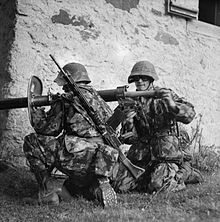RL-83 Blindicide
| RL-83 Blindicide | |
|---|---|
 Swiss Army 8.3 cm Raketenrohr launchers (Blindicide copy) on display | |
| Type | Antitank rocket launcher |
| Place of origin | Belgium |
| Service history | |
| Used by | See Users |
| Production history | |
| Designed | 1950s |
| Manufacturer | Mecar SA |
| Specifications | |
| Mass | 8.4 kg (RL-83) 12.9 kg (RL-100) |
| Length | 1.7 m (RL-83) 1.885 m (RL-100) |
| Crew | 2 |
| Shell | HEAT |
| Caliber | 83 mm, 100 mm |
| Rate of fire | 6 rpm |
| Muzzle velocity | 100 m/s (RL-83) 195 m/s (RL-100) |
| Effective firing range | 400 m (0.25 mi) |
| Maximum firing range | 900 m (0.56 mi) |

The RL-83 Blindicide is primarily an antitank rocket launcher but other rounds could be fired. It was produced by Mecar SA of Belgium and was an improved derivative of the M20A1 Bazooka. Its name roughly means "tank killer", derived from the French "véhicule blindé" (armoured car) and the suffix -cide.
Versions
The Blindicide was also produced in a 100 mm version (the RL-100). The 83mm version fired a 1.6 kilogram projectile with a 0.5 kg warhead, while the 100 mm version fired a 2.75 kg projectile. The rate of fire was six rounds per minute and the range 400 meters for both versions. This rate of fire was considerably in excess of the M20A1 Bazooka since Blindicide used a mechanical firing pin hitting a percussion cap in the tail of the rocket motor rather than a hand grip magneto system that required trailing wires from each rocket to be connected to terminal posts on the launcher as each round was loaded. The muzzle velocity of both versions varied, with the 83 mm version firing at 100 m/s while the 100 mm version fired at 195 m/s.[1] A later round introduced for the RL-83 has a muzzle velocity of 120 m/s and uses a rocket booster to achieve a velocity of 300 m/s. The effective range of this 2.4 kg projectile is 500 meters.
The high-explosive antitank (HEAT) rocket of the RL-83 Blindicide can penetrate 300 millimeters of rolled homogeneous armour or one meter of concrete.[2] Besides HEAT, the Blindicide can also fire anti-personnel, smoke, incendiary and illumination rounds.
A final version of the Blindicide was the RLC-83, a shortened version of the RL-83. The RLC-83 differs from the RL-83 in having a 1.2 meter launch tube. The RLC-83 is intended to be used only with the rocket-boosted long-range projectiles.
Switzerland produced a licence version of the Blindicide, the Raketenrohr 58 (RR 58). The Raketenrohr 80 (RR 80) was an improved version with new aiming system for use by night. The Swiss army had a total of 20,000 RRs in service, all of which have been replaced by the German Panzerfaust 3.[3] Apart from the defensive role the Swiss also used the Raketenrohr 80 to caused controlled avalanches, thus reducing the risks to civilians in avalanche prone areas.
A training round / practice rocket was available for Blindicide. This used a blank 20 mm cartridge to produce a flash and a bang, but the round only fell a few feet in front of the launcher.
A 20 mm Sub-caliber training round was also available. This had a rifled barrel and fired either a plastic or copper projectile. Initially this sub-caliber gun had a wooden body, but later an anodised Aluminium body was used.



Operational history
The Blindicide saw service with the Belgian forces during the Congo crisis.
The Blindicide was also used by Anti British guerrillas during the Aden Emergency. Remains of several projectiles recovered from Aden are held by the Imperial War Museum.
The RL-83 version was used by the Israel Defense Forces during the Six-Day war and the Yom Kippur War
In recent years it has been reported that the Mexican Army deployed Blindicides against improvised armored vehicles in use by drug cartels.[4]
The Blindicide has also been identified in video clips of the Free Syrian Army operating in Syria.
Users

 Bangladesh - Retired
Bangladesh - Retired Belgium - Retired in late 1980's
Belgium - Retired in late 1980's Burundi - In use
Burundi - In use Israel - Retired
Israel - Retired Mexico - In use as of 2011 [5]
Mexico - In use as of 2011 [5] Rwanda - Received via France[6]
Rwanda - Received via France[6] Switzerland - Raketenrohr version Retired[7]
Switzerland - Raketenrohr version Retired[7] Syria - Retired
Syria - Retired Lebanon - Retired ("on the 4th of January 1973, the Belgian government issued an export license to MECAR for the export of 4 Blindicide 83 mm to the Lebanese army." Source Mecar SA)
Lebanon - Retired ("on the 4th of January 1973, the Belgian government issued an export license to MECAR for the export of 4 Blindicide 83 mm to the Lebanese army." Source Mecar SA) Indonesia - Retired formerly used by Navy.
Indonesia - Retired formerly used by Navy. 
Indonesian Navy bazooka, Jalesveva Jayamahe, p123
Notes
- ^ weapon.at.ua
- ^ Jane's Infantry Weapons 1984-85, p. 690.
- ^ The World Defence Almanac 2010 page 214 ISSN 0722-3226 replaced by Panzerfaust-3
- ^ J. Robert, Bunker; Ramirez, Bryon (2013). "Narco Armor Improvised Armored Fighting Vehicles in Mexico" (PDF). Foreign Military Studies Office. Retrieved 3 November 2013.
- ^ J. Robert, Bunker; Ramirez, Bryon (2013). "Narco Armor Improvised Armored Fighting Vehicles in Mexico" (PDF). Foreign Military Studies Office. Retrieved 3 November 2013.
- ^ The path of a genocide: the Rwanda Crisis from Uganda to Zaire
- ^ The World Defence Almanac 2010 page 214 ISSN 0722-3226 replaced by Panzerfaust-3

